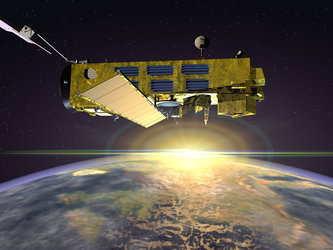Envisat's radar 'eye' opens
Deployment of the 10m-long antenna for Envisat's largest single instrument was successfully concluded at 15:00 CET Monday 2 March. Before launch the ASAR (Advanced Synthetic Aperture Radar) antenna had been folded back and secured to the spacecraft hull with eight Kevlar straps to protect it during the violent lift-off.
ESOC flight controllers in Darmstadt, Germany, spent the previous two days carefully supervising deployment. The motor-hinged ASAR panels had been stacked five high. On Sunday, the operation had commenced as a set of eight thermal knives cut the ASAR's Kevlar bonds.
Then the top two panels were ''flipped' to the right - each such motor-driven movement actually taking about 25 minutes - then the next two panels were flipped leftward. Then the two inner panels on either side were both unfolded outward to create a flat and rigid antenna pointing down to the Earth's surface.

Each of these panel movements did not take much time in themselves, but flight controllers insisted on being in continuous radio contact with the spacecraft as they occurred, in case of any problems.
"They did not want to do this blind," explained Envisat engineer Pierre Viau, observing satellite telemetry with ESA's remaining Envisat team in Kourou. "So they waited for orbits where they could be sure of near-continuous ground station coverage for up to 30 to 40 minutes each time. Also, they liked to have 10 to 12 hours between each deployment".
In the event, final ASAR deployment was confirmed via telemetry from the ground station in Santiago, Chile. The entire operation had gone like clockwork. The antenna will allow ASAR to keep a continuous eye on the Earth's land and sea surface, no matter local cloud cover or time of day.

This is the latest achievement in a so-far untroubled satellite deployment. Following Envisat's successful orbital insertion in the early hours of Friday morning, flight controllers at ESOC in Darmstadt, Germany, unfurled the spacecraft's solar array to make it self-powering.
Saturday was devoted to synchronising Envisat's orbit with that of ERS-2, so the two satellites are able to carry out joint observations in future.
Next is scheduled the Switch On and Data Acquisition Phase (SODAP) and deployment of Envisat's Ka-band antenna for communication with ESA's Artemis spacecraft.















 Germany
Germany
 Austria
Austria
 Belgium
Belgium
 Denmark
Denmark
 Spain
Spain
 Estonia
Estonia
 Finland
Finland
 France
France
 Greece
Greece
 Hungary
Hungary
 Ireland
Ireland
 Italy
Italy
 Luxembourg
Luxembourg
 Norway
Norway
 The Netherlands
The Netherlands
 Poland
Poland
 Portugal
Portugal
 Czechia
Czechia
 Romania
Romania
 United Kingdom
United Kingdom
 Slovenia
Slovenia
 Sweden
Sweden
 Switzerland
Switzerland
































